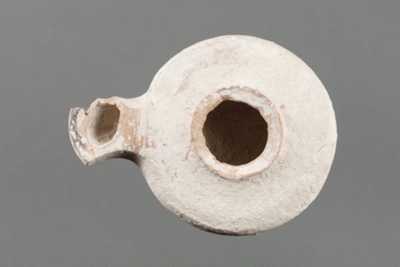< Collection search
< Collection highlights
From:UC Teece Museum of Classical Antiquities
Name/TitleLamp
About this objectMade of a fine, pink clay, and covered with a matt white slip, this is a very plain lamp with minimal decoration. The chipped nozzle has been pared back with a knife to smooth the join to the body, which was made separately. Two parallel grooves have been incised on the top.
This and lamp JLMC 191.04 are lamps of similar shape, both manufactured in Judaea in the Early Imperial period and both probably made for the local Jewish population. This one is a fairly common type often referred to as a Herodian lamp, in reference to a belief scholars once held that production of these lamps began in the time of King Herod. First made around the very end of the first century BCE or beginning of the first century CE, Herodian lamps continued to be produced until the middle of the second century CE.
Herodian lamps were plain, wheel-made with circular oil chambers, large filling holes, spatulate nozzles, flat bases and, in many cases, a ridge around the rim of the filling hole. The plain Herodian lamps contrasted greatly with the discus lamp popular throughout the Roman Empire in the first century CE. They often incorporated a discus (a central disc on the top of the body) decorated with images of human figures and deities, a practice forbidden in Jewish culture.
Date Made25 BCE-170 CE
PeriodEarly Imperial
Place MadeMiddle East
Place NotesJudaea
Medium and MaterialsCeramic: Pottery
Style and IconographyRoman
Style and IconographyJudaean
TechniqueCarving (processes)
TechniqueIncising
TechniqueMolding (forming)
MeasurementsLength 86mm; Width 62mm; Height 26mm
Subject and Association KeywordsSocial life and customs
Named CollectionThe James Logie Memorial Collection, University of Canterbury, New Zealand
Object TypeLamp
Object number195.04
Copyright LicenceAll rights reserved
